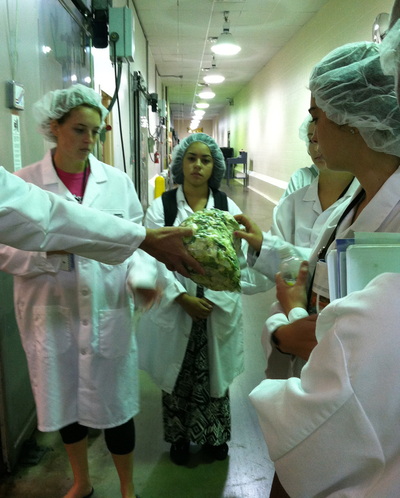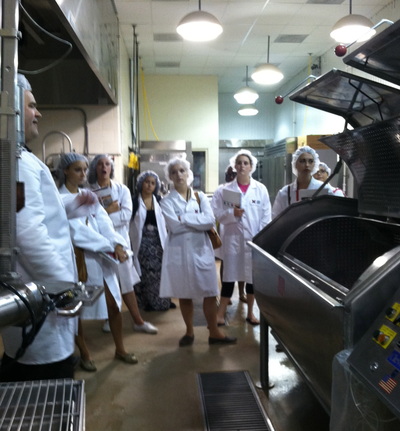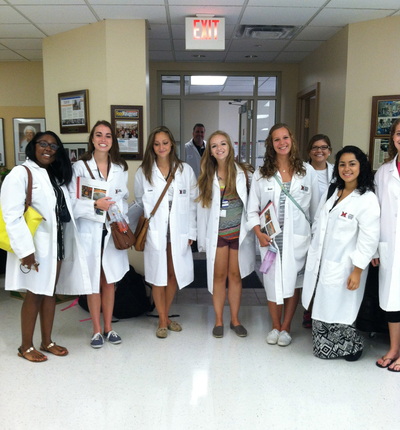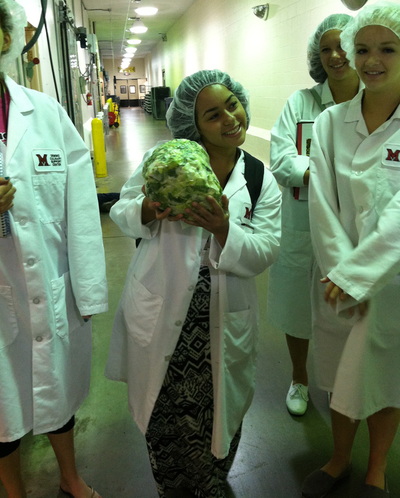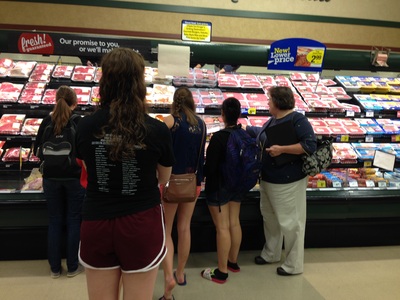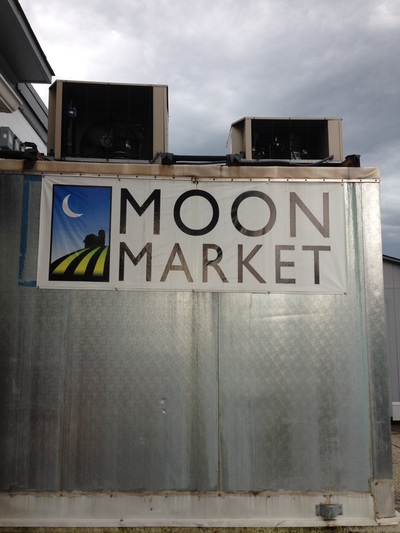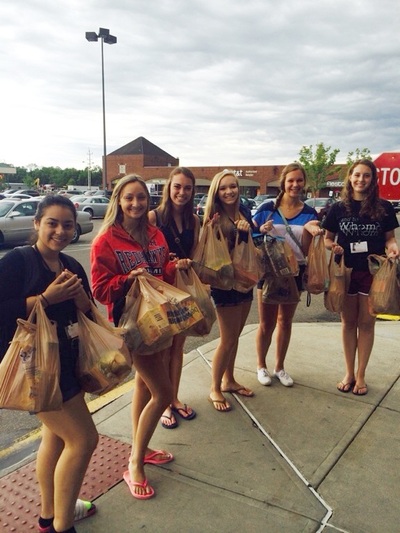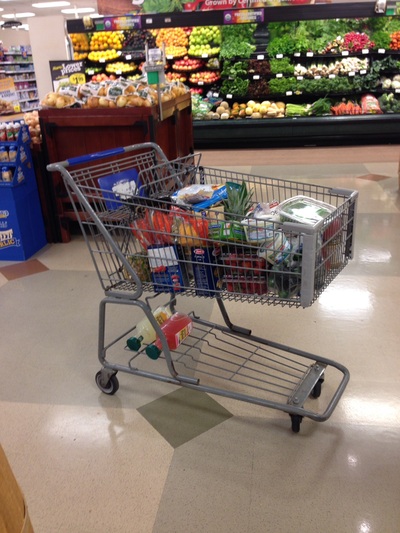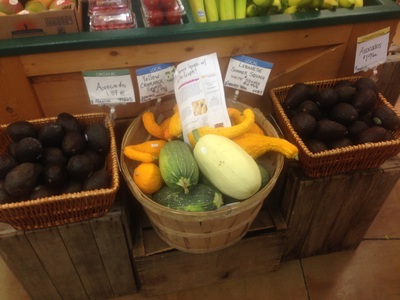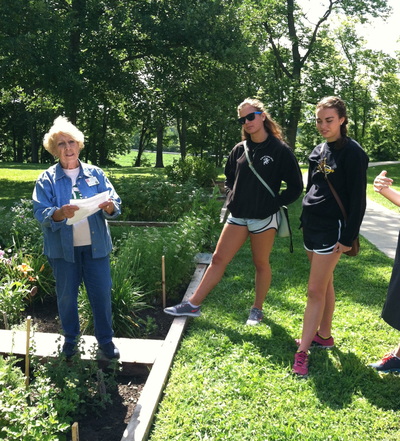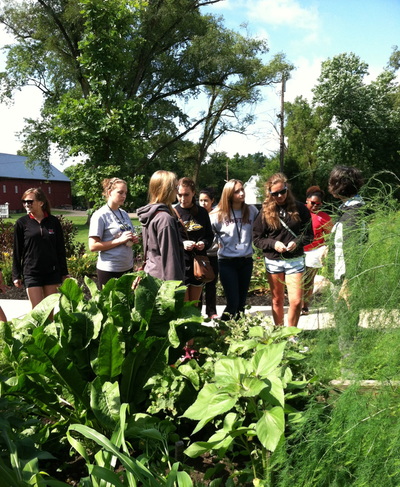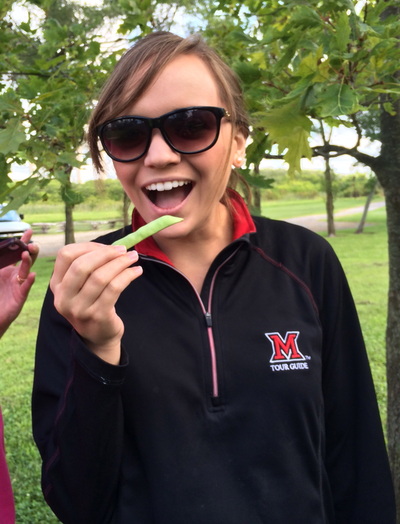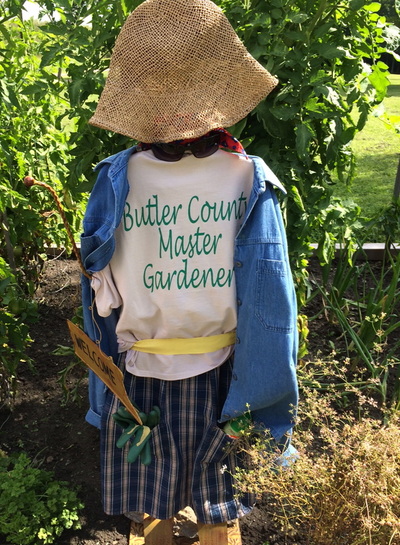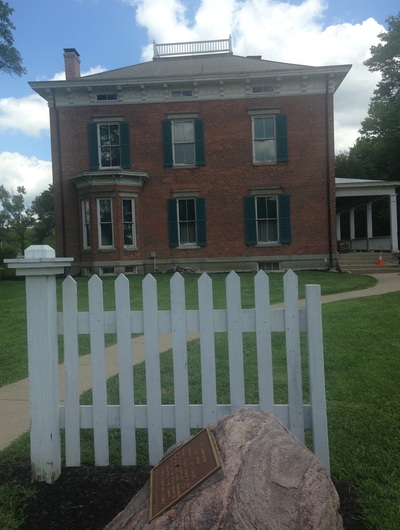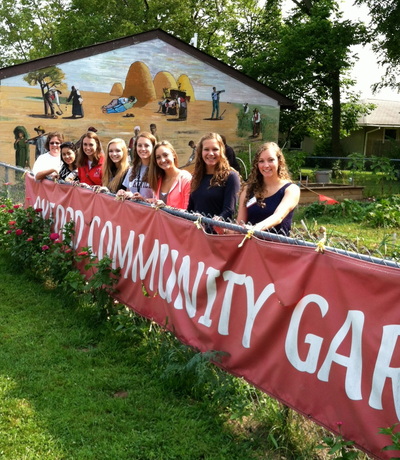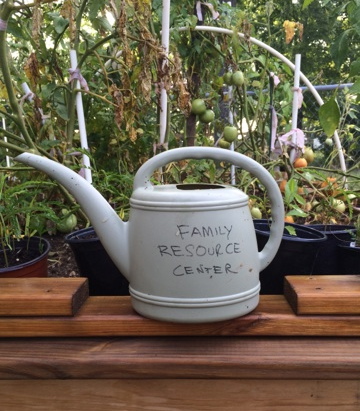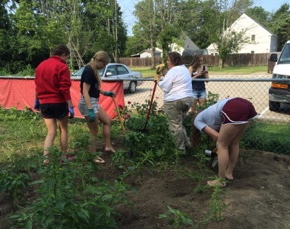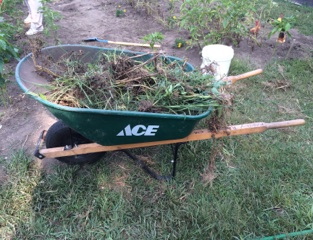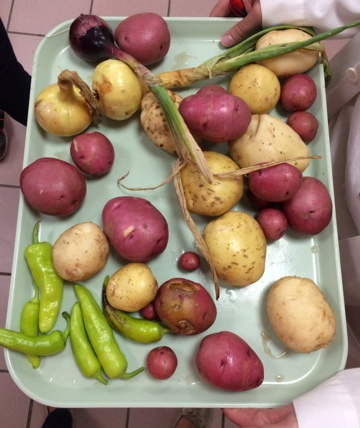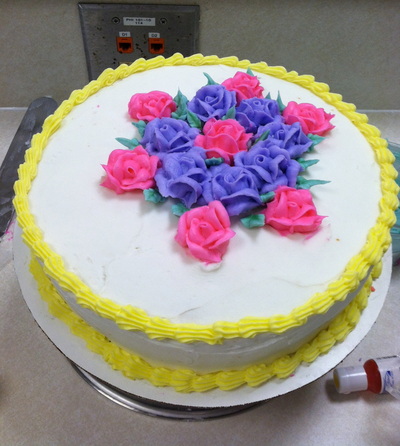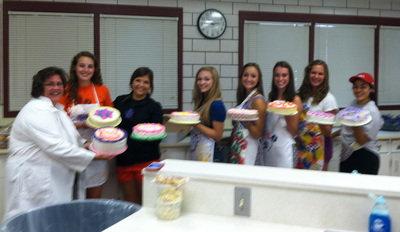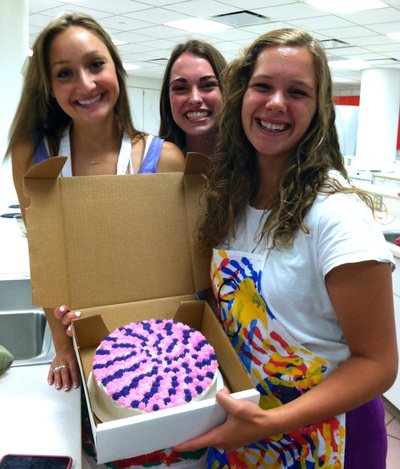Culinary Support Center
Tuesday, July 22, 2014
The Navigating the Dynamics of Nutrition and Dietetics module toured the Demske Culinary Support Center which provides all of the food for the University of Miami in Ohio. The group learned how and where the food was prepared as well as how the food was packaged and distributed throughout the campus. This tour relates to the program because the support center holds the responsibility of making and distributing food with the nutritional values the college students need.
(Katie Atkins)
The Navigating the Dynamics of Nutrition and Dietetics module toured the Demske Culinary Support Center which provides all of the food for the University of Miami in Ohio. The group learned how and where the food was prepared as well as how the food was packaged and distributed throughout the campus. This tour relates to the program because the support center holds the responsibility of making and distributing food with the nutritional values the college students need.
(Katie Atkins)
Kroger and MOON Co-Op
Wednesday, July 23, 2014
We went to Kroger today to grocery shop for meals throughout the week. We looked
for healthy snacks to pack and filling lunches for other field trips we would be going
on. While in Kroger we got the opportunity to talk to the store manager who told us a
few tips when coming to the grocery:
1. Never come hungry
2. Fresh produce is around the perimeter of the store
3. The food at the deli has expiration dates so you know you won't get old meat
4. Sunday is the busiest day of the week so if you want a fast check out come
during the week.
After shopping at Kroger we went to MOON Co‐op. This is a market where they have
fresh local vegetables and food made from organic products. MOON stands for
"Miami Oxford Organic Network" At the store they find farmers and venders that
come bring their products in for consumers to buy. At MOON they do not have a
major business owner. People from around the community pay $150 to be an
"owner" of the company and eventually share in its profits. As of now there are
around 1,000 people that are member of the organization.
These were two very different shopping centers and they attract different people.
Most go to Kroger because it is cheap and food is ready to make when you get home,
there is not much planning involved. MOONCo‐op appeals to people who want fresh
food that is organic and healthy. This food can be a little pricey because of how it is
grown and how much the farmers look after the fruits and vegetables they are
growing. Although both places carry about the same products it depends on how
much people are willing to put into their lifestyle and how much they are wanting to
change in order to get healthy alternatives.
(Catherine Donnelly)
We went to Kroger today to grocery shop for meals throughout the week. We looked
for healthy snacks to pack and filling lunches for other field trips we would be going
on. While in Kroger we got the opportunity to talk to the store manager who told us a
few tips when coming to the grocery:
1. Never come hungry
2. Fresh produce is around the perimeter of the store
3. The food at the deli has expiration dates so you know you won't get old meat
4. Sunday is the busiest day of the week so if you want a fast check out come
during the week.
After shopping at Kroger we went to MOON Co‐op. This is a market where they have
fresh local vegetables and food made from organic products. MOON stands for
"Miami Oxford Organic Network" At the store they find farmers and venders that
come bring their products in for consumers to buy. At MOON they do not have a
major business owner. People from around the community pay $150 to be an
"owner" of the company and eventually share in its profits. As of now there are
around 1,000 people that are member of the organization.
These were two very different shopping centers and they attract different people.
Most go to Kroger because it is cheap and food is ready to make when you get home,
there is not much planning involved. MOONCo‐op appeals to people who want fresh
food that is organic and healthy. This food can be a little pricey because of how it is
grown and how much the farmers look after the fruits and vegetables they are
growing. Although both places carry about the same products it depends on how
much people are willing to put into their lifestyle and how much they are wanting to
change in order to get healthy alternatives.
(Catherine Donnelly)
Herb Garden
As a group we traveled to the Christholm Historic Farm and Herb Garden. This place has significance due to its Amish Mennonite heritage and the information that can be gleamed from the herbs that were used to help those living at that time. Our speaker Cris Trammel, an anthropologist and the Director of Volunteers in Butler County Ohio, talked to us about the history of the land and the importance of the agriculture there. While there we looked at the different plants that were used in the late nineteenth century to help cure people. We were able to touch, feel, smell, and see the plants that were once the cutting edge of medicine.
Nutrition was used in this trip by seeing how people in the past balanced their diet to survive because eating only what they want wasn’t an option. Another group member, Julia Harbach said the trip was “extremely informative due to the information given about the medicinal herbs and merely rubbing them against your skin could cure an infection.”
(Elizabeth Gardner)
Nutrition was used in this trip by seeing how people in the past balanced their diet to survive because eating only what they want wasn’t an option. Another group member, Julia Harbach said the trip was “extremely informative due to the information given about the medicinal herbs and merely rubbing them against your skin could cure an infection.”
(Elizabeth Gardner)
Oxford Community Garden and Community Choice Food Pantry
What a day today was! We started off our day by visiting Marilyn Elzey at the Oxford Community Garden at the Family resource center. At the Community Garden she showed us all of the produce that is growing, we assisted her by weeding and watering the garden. The Family Resource center offers many opportunities such as the English as a Second Language, a GED program and also a cooking class where people can learn how to properly cook the produce that they have been growing.
Our next stop was the local food pantry, Oxford Community Choice Pantry, where we met Bob Ratterman. He is currently the director and has been since last July. This pantry was created by surrounding churches in the area. One really awesome thing that makes this food pantry different than others is that it gives the people two times a month to shop, where as in most other pantries they only allow the people to shop once a month. The Pantry is color coded depending on if it is a fruit, vegetable, grain etc. Each person that comes to the pantry is given their own personal shopper! How great is that? Many of them are nutrition students of Professor Parkinson, their job is to help the customer to be inform and chose for themselves what is healthiest. Key word there is CHOOSE, many food pantries just pass out bags with assorted Items. In Oxford the people have a choice as to what they would like to take home. The Pantry participates in many food drives throughout the year which helps keep them operating, they are also sponsored by both Walmart and Kroger. The Salvation Army also donates money specifically for families with dietary needs, such as gluten free needs.They are always looking for more donations, especially, Peanut Butter, Tuna, and Spaghetti.
After leaving the food Pantry we returned back to the classroom to prepare lunch, one of our favorite parts :) We made ourselves Chicken Strips, brown rice confetti, black bean salad, watermelon salad, and two types of brownies! You can check out our recipes here on our site!
But we weren’t finished there! After lunch we were privileged to meet Lauren, or better known as The Farm Girl with Curls. Lauren talked to us about her life on the farm, she told us about working with all of the baby piglets, she also showed us some fun Farm videos that you can find on her blog http://farmgirlwithcurls.com, by the Peterson Farm Brothers.
Today was packed full of nothing but fun and helping others, I think the others will agree with me when I say we really had a terrific day!
(Anna Turcotte)
Our next stop was the local food pantry, Oxford Community Choice Pantry, where we met Bob Ratterman. He is currently the director and has been since last July. This pantry was created by surrounding churches in the area. One really awesome thing that makes this food pantry different than others is that it gives the people two times a month to shop, where as in most other pantries they only allow the people to shop once a month. The Pantry is color coded depending on if it is a fruit, vegetable, grain etc. Each person that comes to the pantry is given their own personal shopper! How great is that? Many of them are nutrition students of Professor Parkinson, their job is to help the customer to be inform and chose for themselves what is healthiest. Key word there is CHOOSE, many food pantries just pass out bags with assorted Items. In Oxford the people have a choice as to what they would like to take home. The Pantry participates in many food drives throughout the year which helps keep them operating, they are also sponsored by both Walmart and Kroger. The Salvation Army also donates money specifically for families with dietary needs, such as gluten free needs.They are always looking for more donations, especially, Peanut Butter, Tuna, and Spaghetti.
After leaving the food Pantry we returned back to the classroom to prepare lunch, one of our favorite parts :) We made ourselves Chicken Strips, brown rice confetti, black bean salad, watermelon salad, and two types of brownies! You can check out our recipes here on our site!
But we weren’t finished there! After lunch we were privileged to meet Lauren, or better known as The Farm Girl with Curls. Lauren talked to us about her life on the farm, she told us about working with all of the baby piglets, she also showed us some fun Farm videos that you can find on her blog http://farmgirlwithcurls.com, by the Peterson Farm Brothers.
Today was packed full of nothing but fun and helping others, I think the others will agree with me when I say we really had a terrific day!
(Anna Turcotte)
Dialysis Center
Monday, July 28, 2014
The Talawanda Dialysis Center is a treatment facility for patients who are currently receiving dialysis. The patients come in for the process every Monday, Wednesday, and Friday. Professor Parkinson, part time registered dietitian at the facility, first gave us a quick tour of the facility, showing us the exam rooms, treatment room, and other faculty only areas.
We quickly moved to talk about what exactly Professor Parkinson does at her part time job at the treatment center. We learned about how she makes up nutrition plans that cater to each patients individual needs. Some information I learned that she had to consider while developing a menu for the patient was very surprising. For example, dialysis patients can only have eight ounces of liquid a day due to their inability to urinate. Also, because their kidney is not functioning correctly, the amount of phosphorus consumed must be limited because the kidney cannot get rid of the excess phosphorus. This confusion leads to the thyroid trying to even out the amount of phosphorus with the amount of calcium, and most of the time the body resorts to getting the calcium it needs from the bones, which results in the bones being very fragile and easier to break.
Professor Parkinson also gave us multiple papers that show what a blank chart for a patient would look like. She explained how she calculates some of the answers to the forms and what exactly each question means to the patient. This part of her job is one of the most important parts.
The entire experience was very interesting, and I personally learned so much new information that fascinates me and makes me want to learn even more about nutrition.
(Julia Harbach)
The Talawanda Dialysis Center is a treatment facility for patients who are currently receiving dialysis. The patients come in for the process every Monday, Wednesday, and Friday. Professor Parkinson, part time registered dietitian at the facility, first gave us a quick tour of the facility, showing us the exam rooms, treatment room, and other faculty only areas.
We quickly moved to talk about what exactly Professor Parkinson does at her part time job at the treatment center. We learned about how she makes up nutrition plans that cater to each patients individual needs. Some information I learned that she had to consider while developing a menu for the patient was very surprising. For example, dialysis patients can only have eight ounces of liquid a day due to their inability to urinate. Also, because their kidney is not functioning correctly, the amount of phosphorus consumed must be limited because the kidney cannot get rid of the excess phosphorus. This confusion leads to the thyroid trying to even out the amount of phosphorus with the amount of calcium, and most of the time the body resorts to getting the calcium it needs from the bones, which results in the bones being very fragile and easier to break.
Professor Parkinson also gave us multiple papers that show what a blank chart for a patient would look like. She explained how she calculates some of the answers to the forms and what exactly each question means to the patient. This part of her job is one of the most important parts.
The entire experience was very interesting, and I personally learned so much new information that fascinates me and makes me want to learn even more about nutrition.
(Julia Harbach)
